Research Report: Online Shopping Impact on Retail Outlets in Sydney
VerifiedAdded on 2022/10/10
|12
|3697
|4
Report
AI Summary
This research report presents a comparative study of online and offline shopping behaviors in Sydney, Australia, focusing on the factors influencing consumer choices. The study investigates the impact of online shopping on traditional retail outlets, analyzing the challenges faced by retailers and the motivations driving consumers towards online platforms. The research delves into key variables such as income level, convenience, and the attractiveness of online shopping facilities, employing a quantitative research design with a descriptive approach. The methodology includes a survey of 150 randomly selected customers across different age groups, using stratified sampling to ensure representation. The report explores research questions related to the differences between online and offline consumer groups and the factors attracting consumers to online shopping. The analysis highlights the importance of understanding consumer preferences and the need for retailers to adapt to the evolving shopping landscape. The study concludes by discussing ethical considerations and providing recommendations for future research and business strategies within the retail sector. The findings offer valuable insights into the changing dynamics of the shopping experience and the implications for businesses operating in Sydney's retail market.

Research and Decision Making
Paraphrase This Document
Need a fresh take? Get an instant paraphrase of this document with our AI Paraphraser
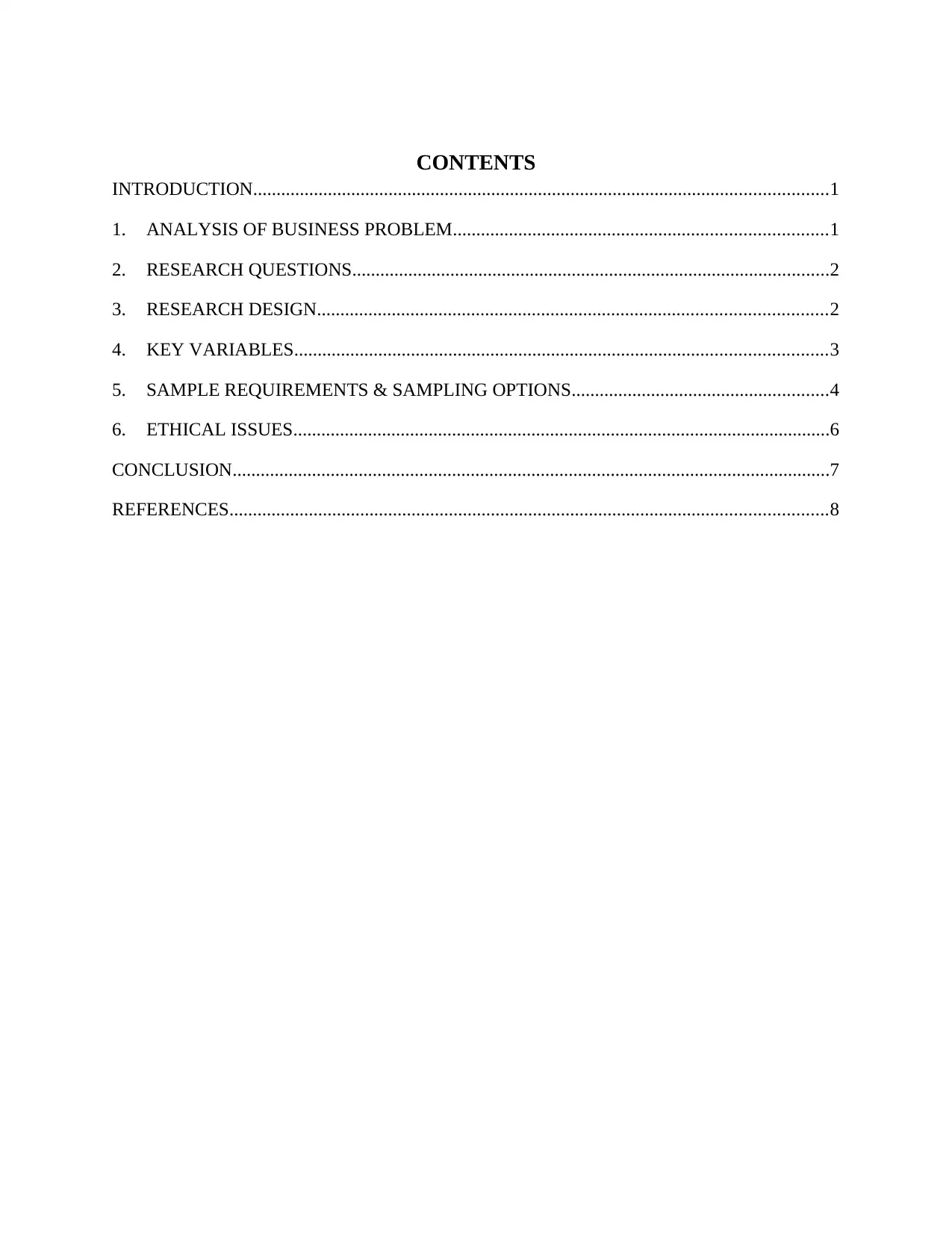
CONTENTS
INTRODUCTION...........................................................................................................................1
1. ANALYSIS OF BUSINESS PROBLEM................................................................................1
2. RESEARCH QUESTIONS......................................................................................................2
3. RESEARCH DESIGN.............................................................................................................2
4. KEY VARIABLES..................................................................................................................3
5. SAMPLE REQUIREMENTS & SAMPLING OPTIONS.......................................................4
6. ETHICAL ISSUES...................................................................................................................6
CONCLUSION................................................................................................................................7
REFERENCES................................................................................................................................8
INTRODUCTION...........................................................................................................................1
1. ANALYSIS OF BUSINESS PROBLEM................................................................................1
2. RESEARCH QUESTIONS......................................................................................................2
3. RESEARCH DESIGN.............................................................................................................2
4. KEY VARIABLES..................................................................................................................3
5. SAMPLE REQUIREMENTS & SAMPLING OPTIONS.......................................................4
6. ETHICAL ISSUES...................................................................................................................6
CONCLUSION................................................................................................................................7
REFERENCES................................................................................................................................8
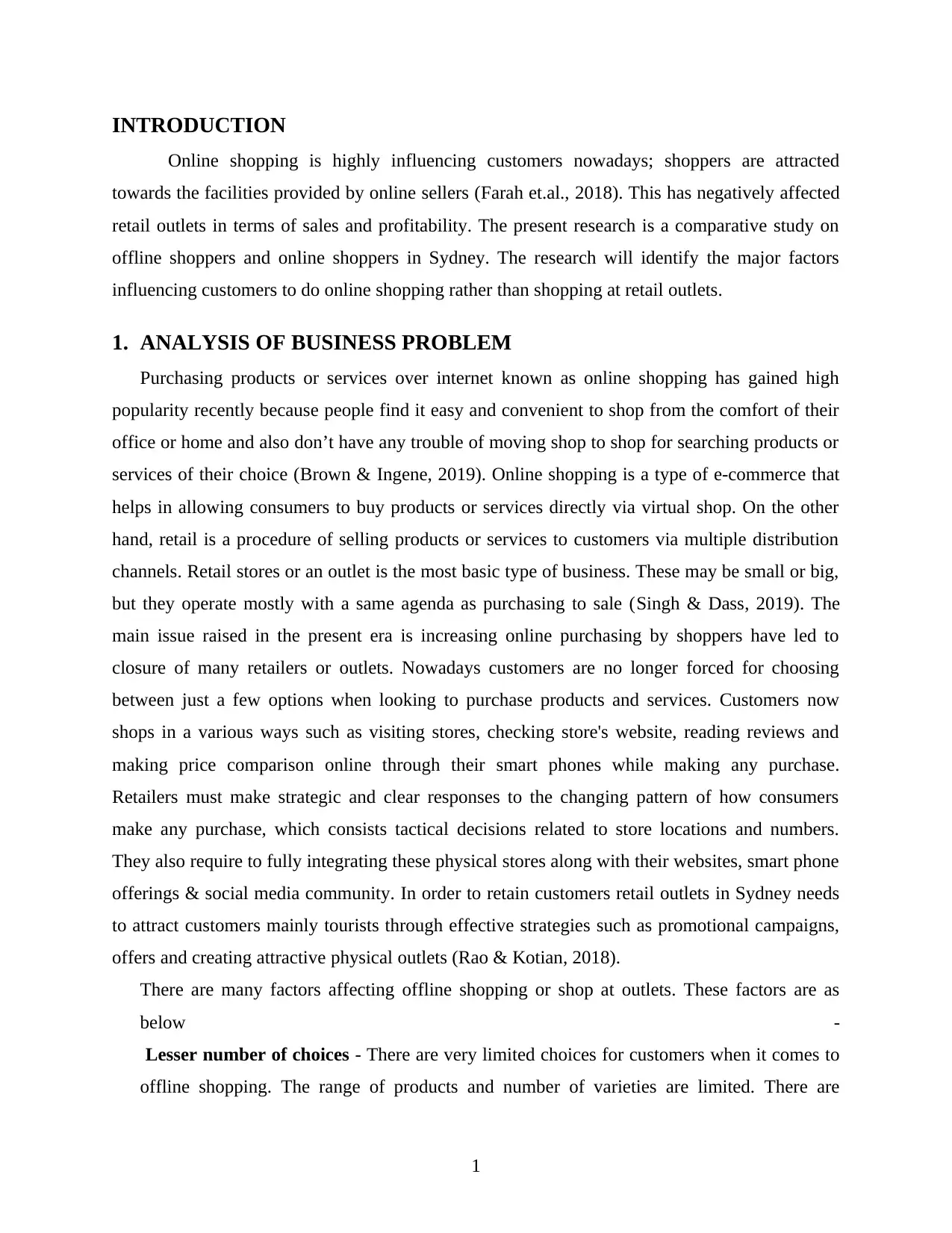
INTRODUCTION
Online shopping is highly influencing customers nowadays; shoppers are attracted
towards the facilities provided by online sellers (Farah et.al., 2018). This has negatively affected
retail outlets in terms of sales and profitability. The present research is a comparative study on
offline shoppers and online shoppers in Sydney. The research will identify the major factors
influencing customers to do online shopping rather than shopping at retail outlets.
1. ANALYSIS OF BUSINESS PROBLEM
Purchasing products or services over internet known as online shopping has gained high
popularity recently because people find it easy and convenient to shop from the comfort of their
office or home and also don’t have any trouble of moving shop to shop for searching products or
services of their choice (Brown & Ingene, 2019). Online shopping is a type of e-commerce that
helps in allowing consumers to buy products or services directly via virtual shop. On the other
hand, retail is a procedure of selling products or services to customers via multiple distribution
channels. Retail stores or an outlet is the most basic type of business. These may be small or big,
but they operate mostly with a same agenda as purchasing to sale (Singh & Dass, 2019). The
main issue raised in the present era is increasing online purchasing by shoppers have led to
closure of many retailers or outlets. Nowadays customers are no longer forced for choosing
between just a few options when looking to purchase products and services. Customers now
shops in a various ways such as visiting stores, checking store's website, reading reviews and
making price comparison online through their smart phones while making any purchase.
Retailers must make strategic and clear responses to the changing pattern of how consumers
make any purchase, which consists tactical decisions related to store locations and numbers.
They also require to fully integrating these physical stores along with their websites, smart phone
offerings & social media community. In order to retain customers retail outlets in Sydney needs
to attract customers mainly tourists through effective strategies such as promotional campaigns,
offers and creating attractive physical outlets (Rao & Kotian, 2018).
There are many factors affecting offline shopping or shop at outlets. These factors are as
below -
Lesser number of choices - There are very limited choices for customers when it comes to
offline shopping. The range of products and number of varieties are limited. There are
1
Online shopping is highly influencing customers nowadays; shoppers are attracted
towards the facilities provided by online sellers (Farah et.al., 2018). This has negatively affected
retail outlets in terms of sales and profitability. The present research is a comparative study on
offline shoppers and online shoppers in Sydney. The research will identify the major factors
influencing customers to do online shopping rather than shopping at retail outlets.
1. ANALYSIS OF BUSINESS PROBLEM
Purchasing products or services over internet known as online shopping has gained high
popularity recently because people find it easy and convenient to shop from the comfort of their
office or home and also don’t have any trouble of moving shop to shop for searching products or
services of their choice (Brown & Ingene, 2019). Online shopping is a type of e-commerce that
helps in allowing consumers to buy products or services directly via virtual shop. On the other
hand, retail is a procedure of selling products or services to customers via multiple distribution
channels. Retail stores or an outlet is the most basic type of business. These may be small or big,
but they operate mostly with a same agenda as purchasing to sale (Singh & Dass, 2019). The
main issue raised in the present era is increasing online purchasing by shoppers have led to
closure of many retailers or outlets. Nowadays customers are no longer forced for choosing
between just a few options when looking to purchase products and services. Customers now
shops in a various ways such as visiting stores, checking store's website, reading reviews and
making price comparison online through their smart phones while making any purchase.
Retailers must make strategic and clear responses to the changing pattern of how consumers
make any purchase, which consists tactical decisions related to store locations and numbers.
They also require to fully integrating these physical stores along with their websites, smart phone
offerings & social media community. In order to retain customers retail outlets in Sydney needs
to attract customers mainly tourists through effective strategies such as promotional campaigns,
offers and creating attractive physical outlets (Rao & Kotian, 2018).
There are many factors affecting offline shopping or shop at outlets. These factors are as
below -
Lesser number of choices - There are very limited choices for customers when it comes to
offline shopping. The range of products and number of varieties are limited. There are
1
⊘ This is a preview!⊘
Do you want full access?
Subscribe today to unlock all pages.

Trusted by 1+ million students worldwide
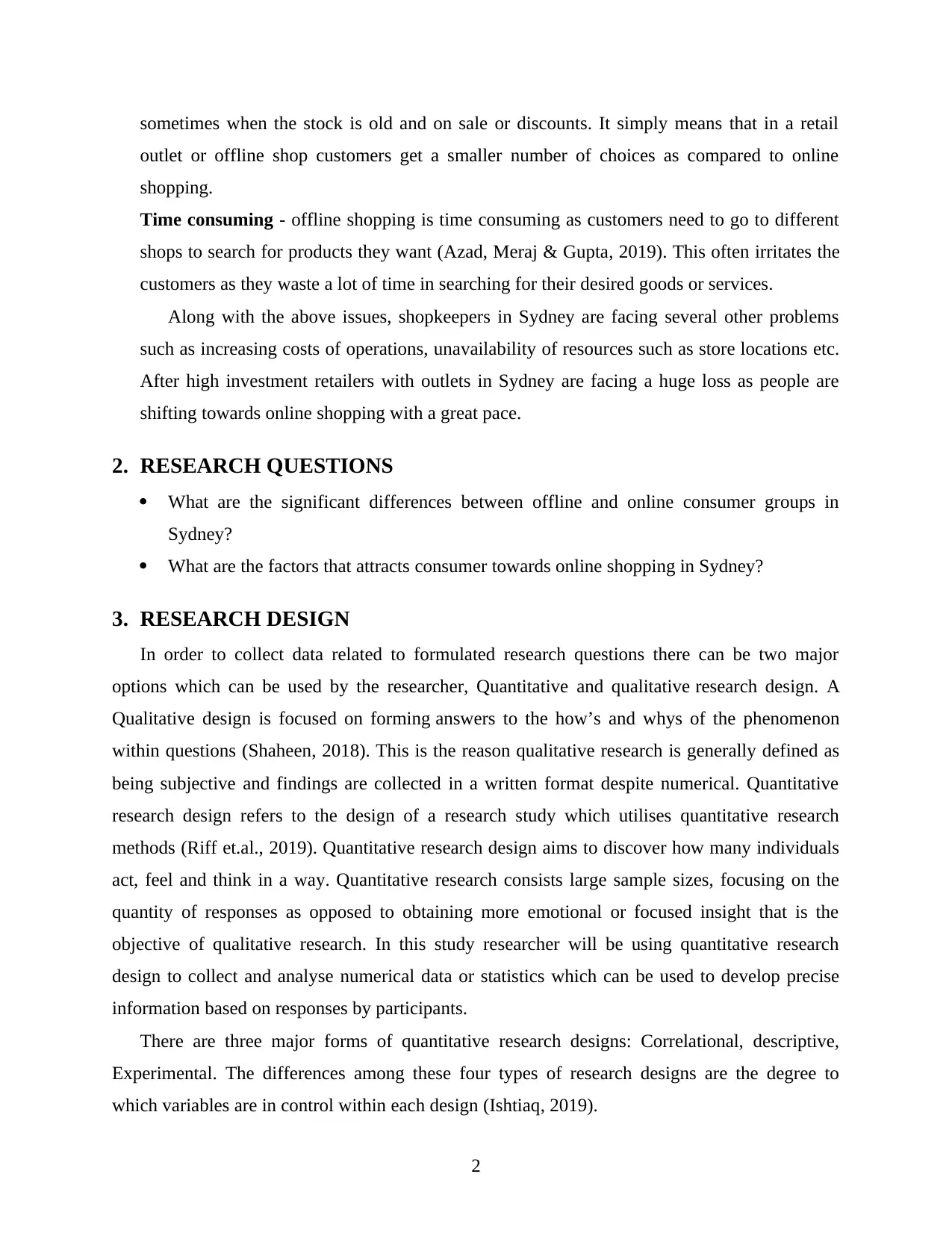
sometimes when the stock is old and on sale or discounts. It simply means that in a retail
outlet or offline shop customers get a smaller number of choices as compared to online
shopping.
Time consuming - offline shopping is time consuming as customers need to go to different
shops to search for products they want (Azad, Meraj & Gupta, 2019). This often irritates the
customers as they waste a lot of time in searching for their desired goods or services.
Along with the above issues, shopkeepers in Sydney are facing several other problems
such as increasing costs of operations, unavailability of resources such as store locations etc.
After high investment retailers with outlets in Sydney are facing a huge loss as people are
shifting towards online shopping with a great pace.
2. RESEARCH QUESTIONS
What are the significant differences between offline and online consumer groups in
Sydney?
What are the factors that attracts consumer towards online shopping in Sydney?
3. RESEARCH DESIGN
In order to collect data related to formulated research questions there can be two major
options which can be used by the researcher, Quantitative and qualitative research design. A
Qualitative design is focused on forming answers to the how’s and whys of the phenomenon
within questions (Shaheen, 2018). This is the reason qualitative research is generally defined as
being subjective and findings are collected in a written format despite numerical. Quantitative
research design refers to the design of a research study which utilises quantitative research
methods (Riff et.al., 2019). Quantitative research design aims to discover how many individuals
act, feel and think in a way. Quantitative research consists large sample sizes, focusing on the
quantity of responses as opposed to obtaining more emotional or focused insight that is the
objective of qualitative research. In this study researcher will be using quantitative research
design to collect and analyse numerical data or statistics which can be used to develop precise
information based on responses by participants.
There are three major forms of quantitative research designs: Correlational, descriptive,
Experimental. The differences among these four types of research designs are the degree to
which variables are in control within each design (Ishtiaq, 2019).
2
outlet or offline shop customers get a smaller number of choices as compared to online
shopping.
Time consuming - offline shopping is time consuming as customers need to go to different
shops to search for products they want (Azad, Meraj & Gupta, 2019). This often irritates the
customers as they waste a lot of time in searching for their desired goods or services.
Along with the above issues, shopkeepers in Sydney are facing several other problems
such as increasing costs of operations, unavailability of resources such as store locations etc.
After high investment retailers with outlets in Sydney are facing a huge loss as people are
shifting towards online shopping with a great pace.
2. RESEARCH QUESTIONS
What are the significant differences between offline and online consumer groups in
Sydney?
What are the factors that attracts consumer towards online shopping in Sydney?
3. RESEARCH DESIGN
In order to collect data related to formulated research questions there can be two major
options which can be used by the researcher, Quantitative and qualitative research design. A
Qualitative design is focused on forming answers to the how’s and whys of the phenomenon
within questions (Shaheen, 2018). This is the reason qualitative research is generally defined as
being subjective and findings are collected in a written format despite numerical. Quantitative
research design refers to the design of a research study which utilises quantitative research
methods (Riff et.al., 2019). Quantitative research design aims to discover how many individuals
act, feel and think in a way. Quantitative research consists large sample sizes, focusing on the
quantity of responses as opposed to obtaining more emotional or focused insight that is the
objective of qualitative research. In this study researcher will be using quantitative research
design to collect and analyse numerical data or statistics which can be used to develop precise
information based on responses by participants.
There are three major forms of quantitative research designs: Correlational, descriptive,
Experimental. The differences among these four types of research designs are the degree to
which variables are in control within each design (Ishtiaq, 2019).
2
Paraphrase This Document
Need a fresh take? Get an instant paraphrase of this document with our AI Paraphraser
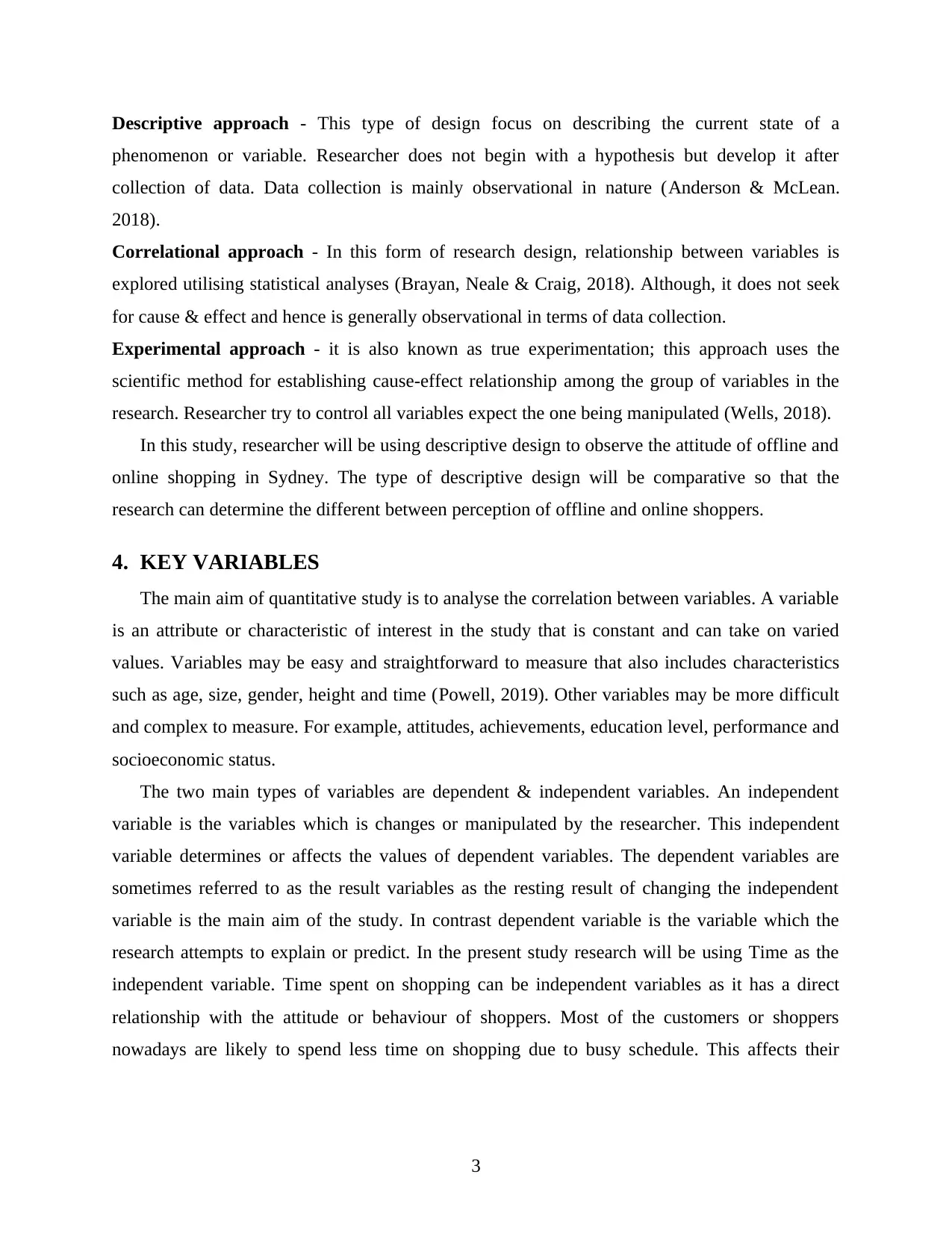
Descriptive approach - This type of design focus on describing the current state of a
phenomenon or variable. Researcher does not begin with a hypothesis but develop it after
collection of data. Data collection is mainly observational in nature (Anderson & McLean.
2018).
Correlational approach - In this form of research design, relationship between variables is
explored utilising statistical analyses (Brayan, Neale & Craig, 2018). Although, it does not seek
for cause & effect and hence is generally observational in terms of data collection.
Experimental approach - it is also known as true experimentation; this approach uses the
scientific method for establishing cause-effect relationship among the group of variables in the
research. Researcher try to control all variables expect the one being manipulated (Wells, 2018).
In this study, researcher will be using descriptive design to observe the attitude of offline and
online shopping in Sydney. The type of descriptive design will be comparative so that the
research can determine the different between perception of offline and online shoppers.
4. KEY VARIABLES
The main aim of quantitative study is to analyse the correlation between variables. A variable
is an attribute or characteristic of interest in the study that is constant and can take on varied
values. Variables may be easy and straightforward to measure that also includes characteristics
such as age, size, gender, height and time (Powell, 2019). Other variables may be more difficult
and complex to measure. For example, attitudes, achievements, education level, performance and
socioeconomic status.
The two main types of variables are dependent & independent variables. An independent
variable is the variables which is changes or manipulated by the researcher. This independent
variable determines or affects the values of dependent variables. The dependent variables are
sometimes referred to as the result variables as the resting result of changing the independent
variable is the main aim of the study. In contrast dependent variable is the variable which the
research attempts to explain or predict. In the present study research will be using Time as the
independent variable. Time spent on shopping can be independent variables as it has a direct
relationship with the attitude or behaviour of shoppers. Most of the customers or shoppers
nowadays are likely to spend less time on shopping due to busy schedule. This affects their
3
phenomenon or variable. Researcher does not begin with a hypothesis but develop it after
collection of data. Data collection is mainly observational in nature (Anderson & McLean.
2018).
Correlational approach - In this form of research design, relationship between variables is
explored utilising statistical analyses (Brayan, Neale & Craig, 2018). Although, it does not seek
for cause & effect and hence is generally observational in terms of data collection.
Experimental approach - it is also known as true experimentation; this approach uses the
scientific method for establishing cause-effect relationship among the group of variables in the
research. Researcher try to control all variables expect the one being manipulated (Wells, 2018).
In this study, researcher will be using descriptive design to observe the attitude of offline and
online shopping in Sydney. The type of descriptive design will be comparative so that the
research can determine the different between perception of offline and online shoppers.
4. KEY VARIABLES
The main aim of quantitative study is to analyse the correlation between variables. A variable
is an attribute or characteristic of interest in the study that is constant and can take on varied
values. Variables may be easy and straightforward to measure that also includes characteristics
such as age, size, gender, height and time (Powell, 2019). Other variables may be more difficult
and complex to measure. For example, attitudes, achievements, education level, performance and
socioeconomic status.
The two main types of variables are dependent & independent variables. An independent
variable is the variables which is changes or manipulated by the researcher. This independent
variable determines or affects the values of dependent variables. The dependent variables are
sometimes referred to as the result variables as the resting result of changing the independent
variable is the main aim of the study. In contrast dependent variable is the variable which the
research attempts to explain or predict. In the present study research will be using Time as the
independent variable. Time spent on shopping can be independent variables as it has a direct
relationship with the attitude or behaviour of shoppers. Most of the customers or shoppers
nowadays are likely to spend less time on shopping due to busy schedule. This affects their
3
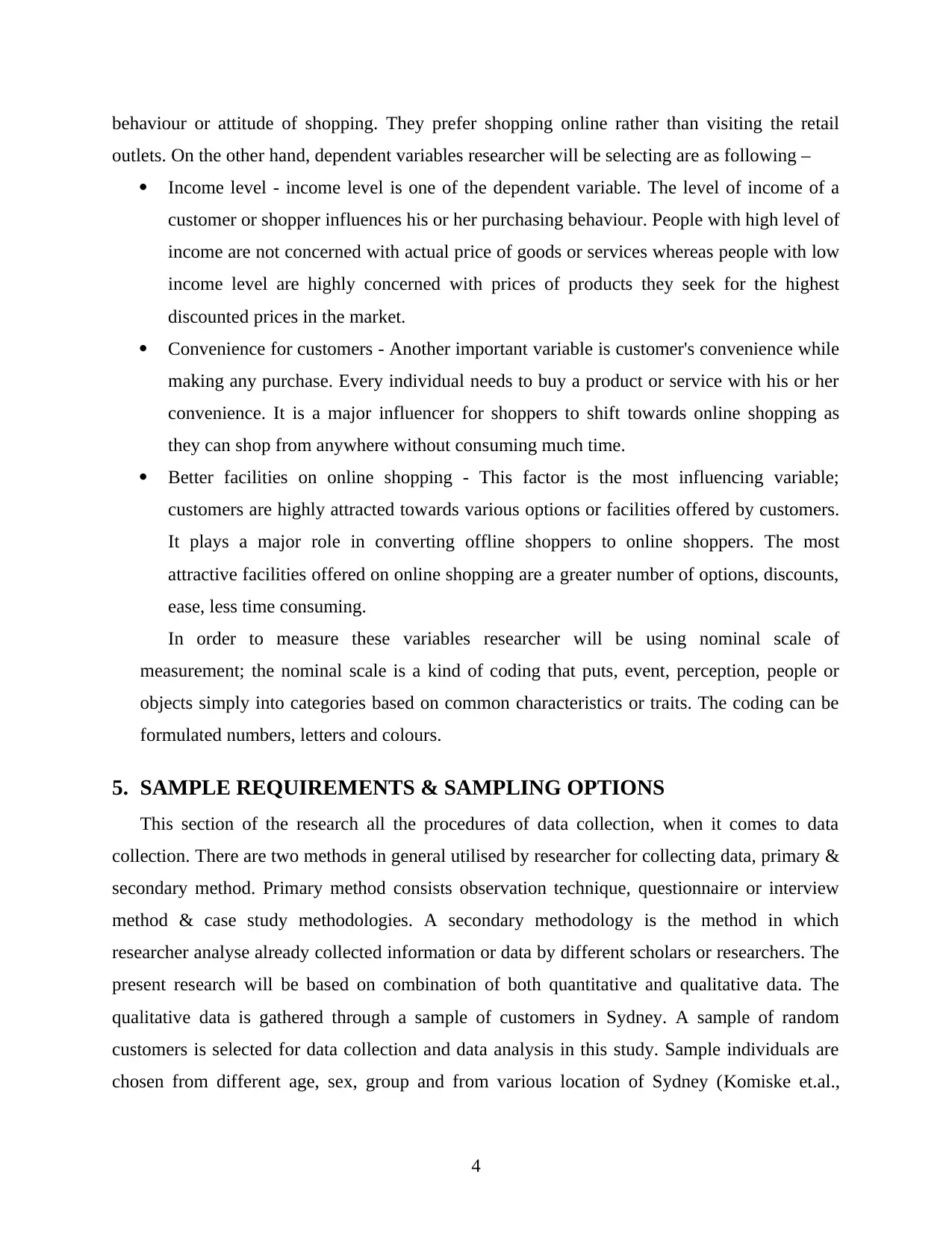
behaviour or attitude of shopping. They prefer shopping online rather than visiting the retail
outlets. On the other hand, dependent variables researcher will be selecting are as following –
Income level - income level is one of the dependent variable. The level of income of a
customer or shopper influences his or her purchasing behaviour. People with high level of
income are not concerned with actual price of goods or services whereas people with low
income level are highly concerned with prices of products they seek for the highest
discounted prices in the market.
Convenience for customers - Another important variable is customer's convenience while
making any purchase. Every individual needs to buy a product or service with his or her
convenience. It is a major influencer for shoppers to shift towards online shopping as
they can shop from anywhere without consuming much time.
Better facilities on online shopping - This factor is the most influencing variable;
customers are highly attracted towards various options or facilities offered by customers.
It plays a major role in converting offline shoppers to online shoppers. The most
attractive facilities offered on online shopping are a greater number of options, discounts,
ease, less time consuming.
In order to measure these variables researcher will be using nominal scale of
measurement; the nominal scale is a kind of coding that puts, event, perception, people or
objects simply into categories based on common characteristics or traits. The coding can be
formulated numbers, letters and colours.
5. SAMPLE REQUIREMENTS & SAMPLING OPTIONS
This section of the research all the procedures of data collection, when it comes to data
collection. There are two methods in general utilised by researcher for collecting data, primary &
secondary method. Primary method consists observation technique, questionnaire or interview
method & case study methodologies. A secondary methodology is the method in which
researcher analyse already collected information or data by different scholars or researchers. The
present research will be based on combination of both quantitative and qualitative data. The
qualitative data is gathered through a sample of customers in Sydney. A sample of random
customers is selected for data collection and data analysis in this study. Sample individuals are
chosen from different age, sex, group and from various location of Sydney (Komiske et.al.,
4
outlets. On the other hand, dependent variables researcher will be selecting are as following –
Income level - income level is one of the dependent variable. The level of income of a
customer or shopper influences his or her purchasing behaviour. People with high level of
income are not concerned with actual price of goods or services whereas people with low
income level are highly concerned with prices of products they seek for the highest
discounted prices in the market.
Convenience for customers - Another important variable is customer's convenience while
making any purchase. Every individual needs to buy a product or service with his or her
convenience. It is a major influencer for shoppers to shift towards online shopping as
they can shop from anywhere without consuming much time.
Better facilities on online shopping - This factor is the most influencing variable;
customers are highly attracted towards various options or facilities offered by customers.
It plays a major role in converting offline shoppers to online shoppers. The most
attractive facilities offered on online shopping are a greater number of options, discounts,
ease, less time consuming.
In order to measure these variables researcher will be using nominal scale of
measurement; the nominal scale is a kind of coding that puts, event, perception, people or
objects simply into categories based on common characteristics or traits. The coding can be
formulated numbers, letters and colours.
5. SAMPLE REQUIREMENTS & SAMPLING OPTIONS
This section of the research all the procedures of data collection, when it comes to data
collection. There are two methods in general utilised by researcher for collecting data, primary &
secondary method. Primary method consists observation technique, questionnaire or interview
method & case study methodologies. A secondary methodology is the method in which
researcher analyse already collected information or data by different scholars or researchers. The
present research will be based on combination of both quantitative and qualitative data. The
qualitative data is gathered through a sample of customers in Sydney. A sample of random
customers is selected for data collection and data analysis in this study. Sample individuals are
chosen from different age, sex, group and from various location of Sydney (Komiske et.al.,
4
⊘ This is a preview!⊘
Do you want full access?
Subscribe today to unlock all pages.

Trusted by 1+ million students worldwide
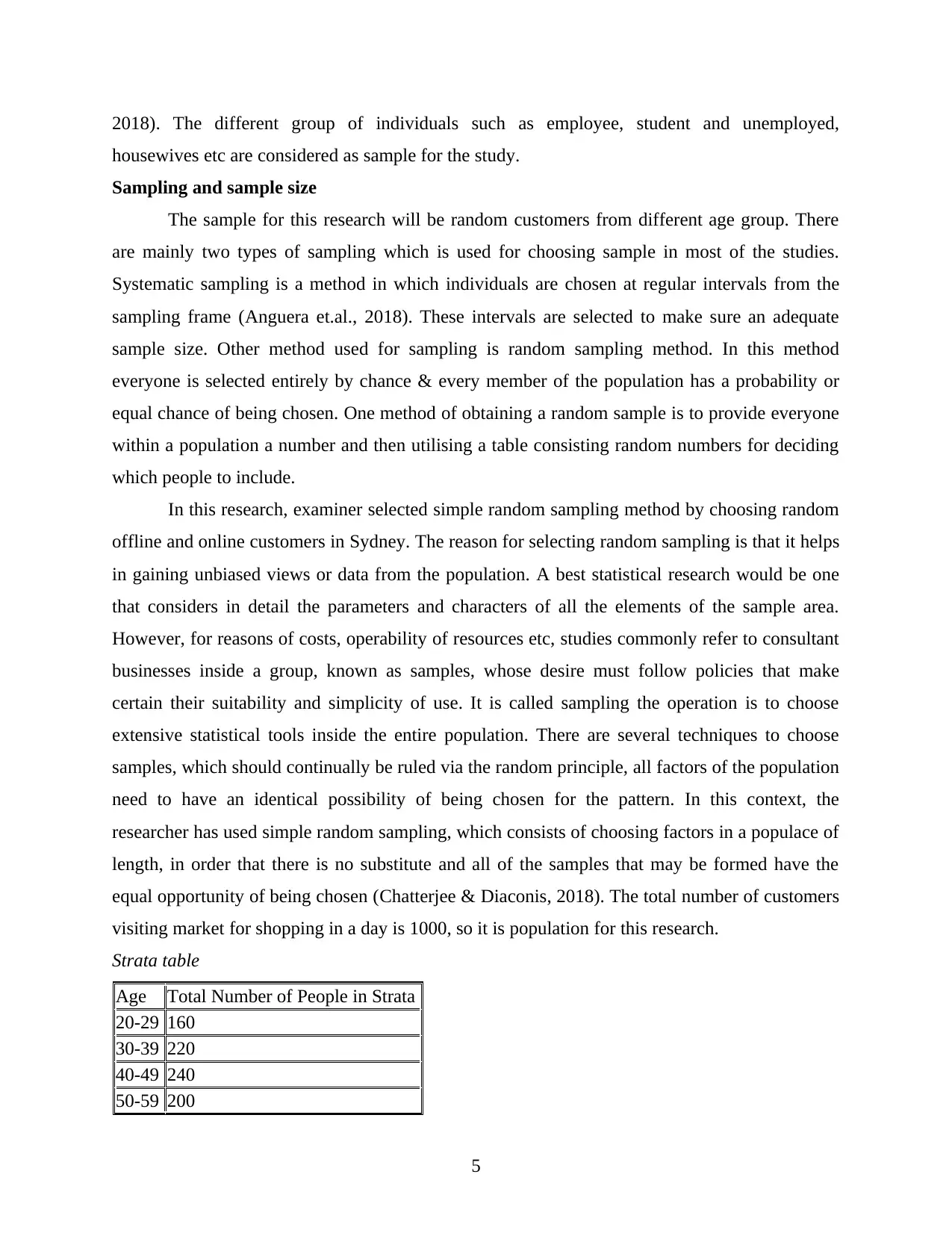
2018). The different group of individuals such as employee, student and unemployed,
housewives etc are considered as sample for the study.
Sampling and sample size
The sample for this research will be random customers from different age group. There
are mainly two types of sampling which is used for choosing sample in most of the studies.
Systematic sampling is a method in which individuals are chosen at regular intervals from the
sampling frame (Anguera et.al., 2018). These intervals are selected to make sure an adequate
sample size. Other method used for sampling is random sampling method. In this method
everyone is selected entirely by chance & every member of the population has a probability or
equal chance of being chosen. One method of obtaining a random sample is to provide everyone
within a population a number and then utilising a table consisting random numbers for deciding
which people to include.
In this research, examiner selected simple random sampling method by choosing random
offline and online customers in Sydney. The reason for selecting random sampling is that it helps
in gaining unbiased views or data from the population. A best statistical research would be one
that considers in detail the parameters and characters of all the elements of the sample area.
However, for reasons of costs, operability of resources etc, studies commonly refer to consultant
businesses inside a group, known as samples, whose desire must follow policies that make
certain their suitability and simplicity of use. It is called sampling the operation is to choose
extensive statistical tools inside the entire population. There are several techniques to choose
samples, which should continually be ruled via the random principle, all factors of the population
need to have an identical possibility of being chosen for the pattern. In this context, the
researcher has used simple random sampling, which consists of choosing factors in a populace of
length, in order that there is no substitute and all of the samples that may be formed have the
equal opportunity of being chosen (Chatterjee & Diaconis, 2018). The total number of customers
visiting market for shopping in a day is 1000, so it is population for this research.
Strata table
Age Total Number of People in Strata
20-29 160
30-39 220
40-49 240
50-59 200
5
housewives etc are considered as sample for the study.
Sampling and sample size
The sample for this research will be random customers from different age group. There
are mainly two types of sampling which is used for choosing sample in most of the studies.
Systematic sampling is a method in which individuals are chosen at regular intervals from the
sampling frame (Anguera et.al., 2018). These intervals are selected to make sure an adequate
sample size. Other method used for sampling is random sampling method. In this method
everyone is selected entirely by chance & every member of the population has a probability or
equal chance of being chosen. One method of obtaining a random sample is to provide everyone
within a population a number and then utilising a table consisting random numbers for deciding
which people to include.
In this research, examiner selected simple random sampling method by choosing random
offline and online customers in Sydney. The reason for selecting random sampling is that it helps
in gaining unbiased views or data from the population. A best statistical research would be one
that considers in detail the parameters and characters of all the elements of the sample area.
However, for reasons of costs, operability of resources etc, studies commonly refer to consultant
businesses inside a group, known as samples, whose desire must follow policies that make
certain their suitability and simplicity of use. It is called sampling the operation is to choose
extensive statistical tools inside the entire population. There are several techniques to choose
samples, which should continually be ruled via the random principle, all factors of the population
need to have an identical possibility of being chosen for the pattern. In this context, the
researcher has used simple random sampling, which consists of choosing factors in a populace of
length, in order that there is no substitute and all of the samples that may be formed have the
equal opportunity of being chosen (Chatterjee & Diaconis, 2018). The total number of customers
visiting market for shopping in a day is 1000, so it is population for this research.
Strata table
Age Total Number of People in Strata
20-29 160
30-39 220
40-49 240
50-59 200
5
Paraphrase This Document
Need a fresh take? Get an instant paraphrase of this document with our AI Paraphraser
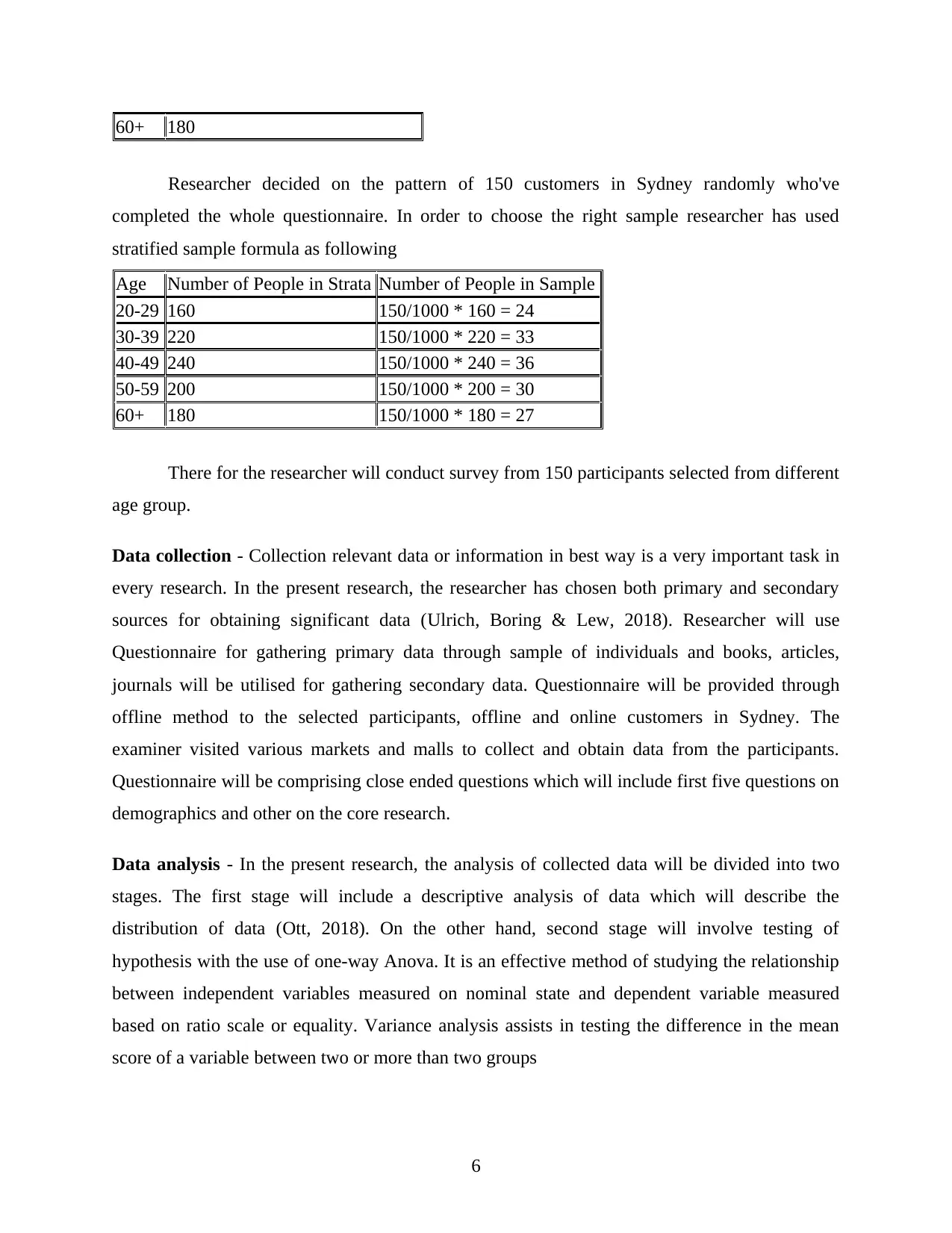
60+ 180
Researcher decided on the pattern of 150 customers in Sydney randomly who've
completed the whole questionnaire. In order to choose the right sample researcher has used
stratified sample formula as following
Age Number of People in Strata Number of People in Sample
20-29 160 150/1000 * 160 = 24
30-39 220 150/1000 * 220 = 33
40-49 240 150/1000 * 240 = 36
50-59 200 150/1000 * 200 = 30
60+ 180 150/1000 * 180 = 27
There for the researcher will conduct survey from 150 participants selected from different
age group.
Data collection - Collection relevant data or information in best way is a very important task in
every research. In the present research, the researcher has chosen both primary and secondary
sources for obtaining significant data (Ulrich, Boring & Lew, 2018). Researcher will use
Questionnaire for gathering primary data through sample of individuals and books, articles,
journals will be utilised for gathering secondary data. Questionnaire will be provided through
offline method to the selected participants, offline and online customers in Sydney. The
examiner visited various markets and malls to collect and obtain data from the participants.
Questionnaire will be comprising close ended questions which will include first five questions on
demographics and other on the core research.
Data analysis - In the present research, the analysis of collected data will be divided into two
stages. The first stage will include a descriptive analysis of data which will describe the
distribution of data (Ott, 2018). On the other hand, second stage will involve testing of
hypothesis with the use of one-way Anova. It is an effective method of studying the relationship
between independent variables measured on nominal state and dependent variable measured
based on ratio scale or equality. Variance analysis assists in testing the difference in the mean
score of a variable between two or more than two groups
6
Researcher decided on the pattern of 150 customers in Sydney randomly who've
completed the whole questionnaire. In order to choose the right sample researcher has used
stratified sample formula as following
Age Number of People in Strata Number of People in Sample
20-29 160 150/1000 * 160 = 24
30-39 220 150/1000 * 220 = 33
40-49 240 150/1000 * 240 = 36
50-59 200 150/1000 * 200 = 30
60+ 180 150/1000 * 180 = 27
There for the researcher will conduct survey from 150 participants selected from different
age group.
Data collection - Collection relevant data or information in best way is a very important task in
every research. In the present research, the researcher has chosen both primary and secondary
sources for obtaining significant data (Ulrich, Boring & Lew, 2018). Researcher will use
Questionnaire for gathering primary data through sample of individuals and books, articles,
journals will be utilised for gathering secondary data. Questionnaire will be provided through
offline method to the selected participants, offline and online customers in Sydney. The
examiner visited various markets and malls to collect and obtain data from the participants.
Questionnaire will be comprising close ended questions which will include first five questions on
demographics and other on the core research.
Data analysis - In the present research, the analysis of collected data will be divided into two
stages. The first stage will include a descriptive analysis of data which will describe the
distribution of data (Ott, 2018). On the other hand, second stage will involve testing of
hypothesis with the use of one-way Anova. It is an effective method of studying the relationship
between independent variables measured on nominal state and dependent variable measured
based on ratio scale or equality. Variance analysis assists in testing the difference in the mean
score of a variable between two or more than two groups
6
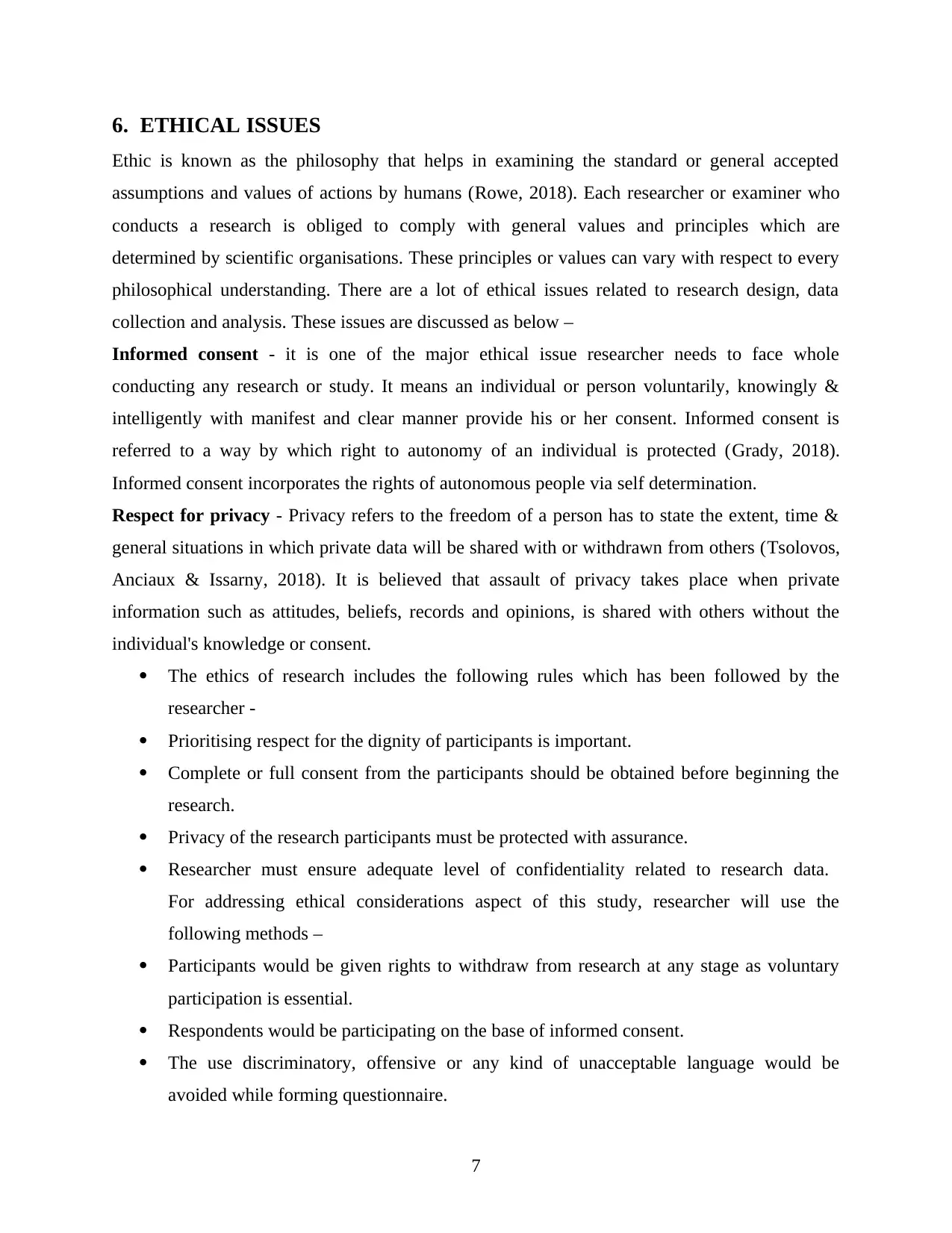
6. ETHICAL ISSUES
Ethic is known as the philosophy that helps in examining the standard or general accepted
assumptions and values of actions by humans (Rowe, 2018). Each researcher or examiner who
conducts a research is obliged to comply with general values and principles which are
determined by scientific organisations. These principles or values can vary with respect to every
philosophical understanding. There are a lot of ethical issues related to research design, data
collection and analysis. These issues are discussed as below –
Informed consent - it is one of the major ethical issue researcher needs to face whole
conducting any research or study. It means an individual or person voluntarily, knowingly &
intelligently with manifest and clear manner provide his or her consent. Informed consent is
referred to a way by which right to autonomy of an individual is protected (Grady, 2018).
Informed consent incorporates the rights of autonomous people via self determination.
Respect for privacy - Privacy refers to the freedom of a person has to state the extent, time &
general situations in which private data will be shared with or withdrawn from others (Tsolovos,
Anciaux & Issarny, 2018). It is believed that assault of privacy takes place when private
information such as attitudes, beliefs, records and opinions, is shared with others without the
individual's knowledge or consent.
The ethics of research includes the following rules which has been followed by the
researcher -
Prioritising respect for the dignity of participants is important.
Complete or full consent from the participants should be obtained before beginning the
research.
Privacy of the research participants must be protected with assurance.
Researcher must ensure adequate level of confidentiality related to research data.
For addressing ethical considerations aspect of this study, researcher will use the
following methods –
Participants would be given rights to withdraw from research at any stage as voluntary
participation is essential.
Respondents would be participating on the base of informed consent.
The use discriminatory, offensive or any kind of unacceptable language would be
avoided while forming questionnaire.
7
Ethic is known as the philosophy that helps in examining the standard or general accepted
assumptions and values of actions by humans (Rowe, 2018). Each researcher or examiner who
conducts a research is obliged to comply with general values and principles which are
determined by scientific organisations. These principles or values can vary with respect to every
philosophical understanding. There are a lot of ethical issues related to research design, data
collection and analysis. These issues are discussed as below –
Informed consent - it is one of the major ethical issue researcher needs to face whole
conducting any research or study. It means an individual or person voluntarily, knowingly &
intelligently with manifest and clear manner provide his or her consent. Informed consent is
referred to a way by which right to autonomy of an individual is protected (Grady, 2018).
Informed consent incorporates the rights of autonomous people via self determination.
Respect for privacy - Privacy refers to the freedom of a person has to state the extent, time &
general situations in which private data will be shared with or withdrawn from others (Tsolovos,
Anciaux & Issarny, 2018). It is believed that assault of privacy takes place when private
information such as attitudes, beliefs, records and opinions, is shared with others without the
individual's knowledge or consent.
The ethics of research includes the following rules which has been followed by the
researcher -
Prioritising respect for the dignity of participants is important.
Complete or full consent from the participants should be obtained before beginning the
research.
Privacy of the research participants must be protected with assurance.
Researcher must ensure adequate level of confidentiality related to research data.
For addressing ethical considerations aspect of this study, researcher will use the
following methods –
Participants would be given rights to withdraw from research at any stage as voluntary
participation is essential.
Respondents would be participating on the base of informed consent.
The use discriminatory, offensive or any kind of unacceptable language would be
avoided while forming questionnaire.
7
⊘ This is a preview!⊘
Do you want full access?
Subscribe today to unlock all pages.

Trusted by 1+ million students worldwide
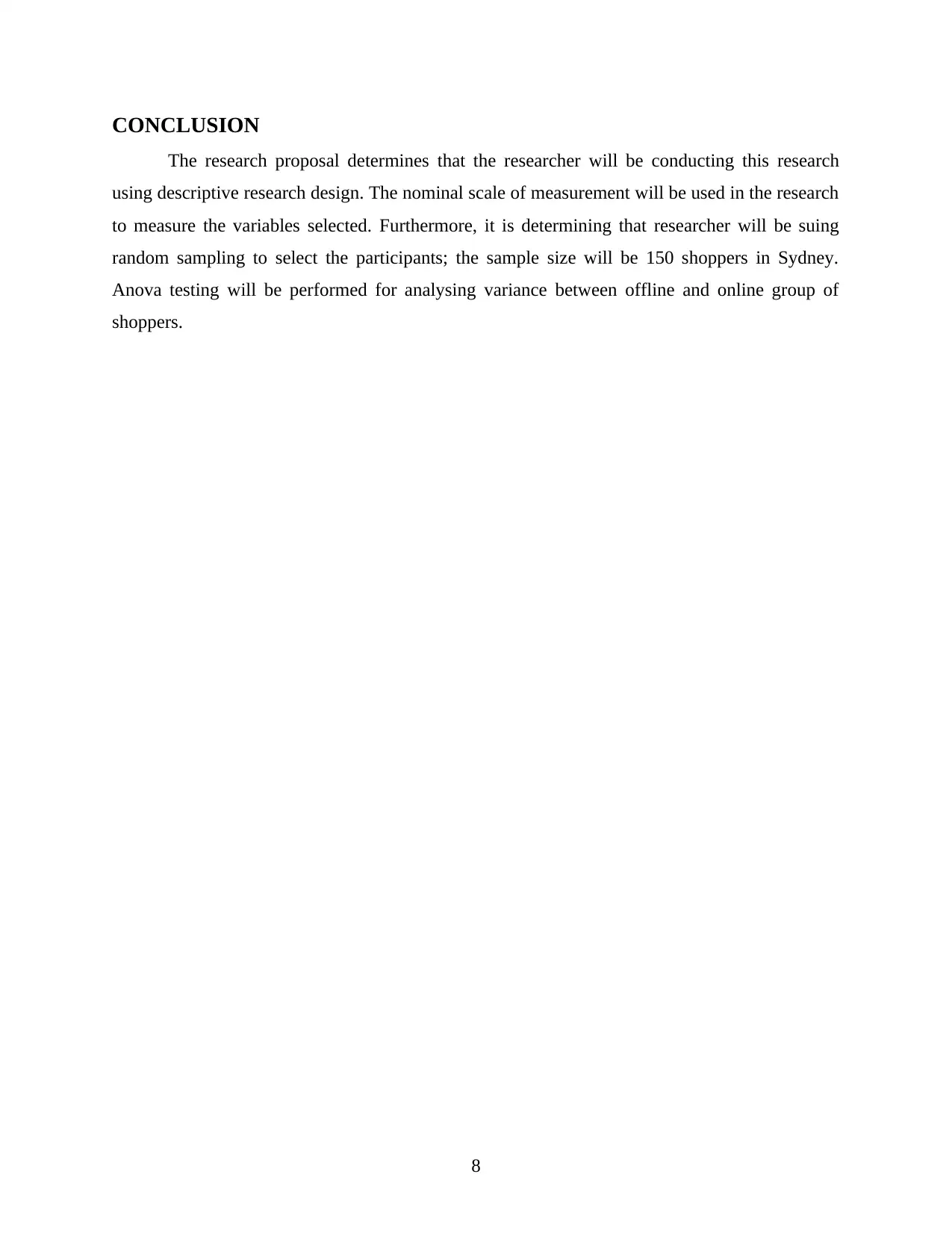
CONCLUSION
The research proposal determines that the researcher will be conducting this research
using descriptive research design. The nominal scale of measurement will be used in the research
to measure the variables selected. Furthermore, it is determining that researcher will be suing
random sampling to select the participants; the sample size will be 150 shoppers in Sydney.
Anova testing will be performed for analysing variance between offline and online group of
shoppers.
8
The research proposal determines that the researcher will be conducting this research
using descriptive research design. The nominal scale of measurement will be used in the research
to measure the variables selected. Furthermore, it is determining that researcher will be suing
random sampling to select the participants; the sample size will be 150 shoppers in Sydney.
Anova testing will be performed for analysing variance between offline and online group of
shoppers.
8
Paraphrase This Document
Need a fresh take? Get an instant paraphrase of this document with our AI Paraphraser
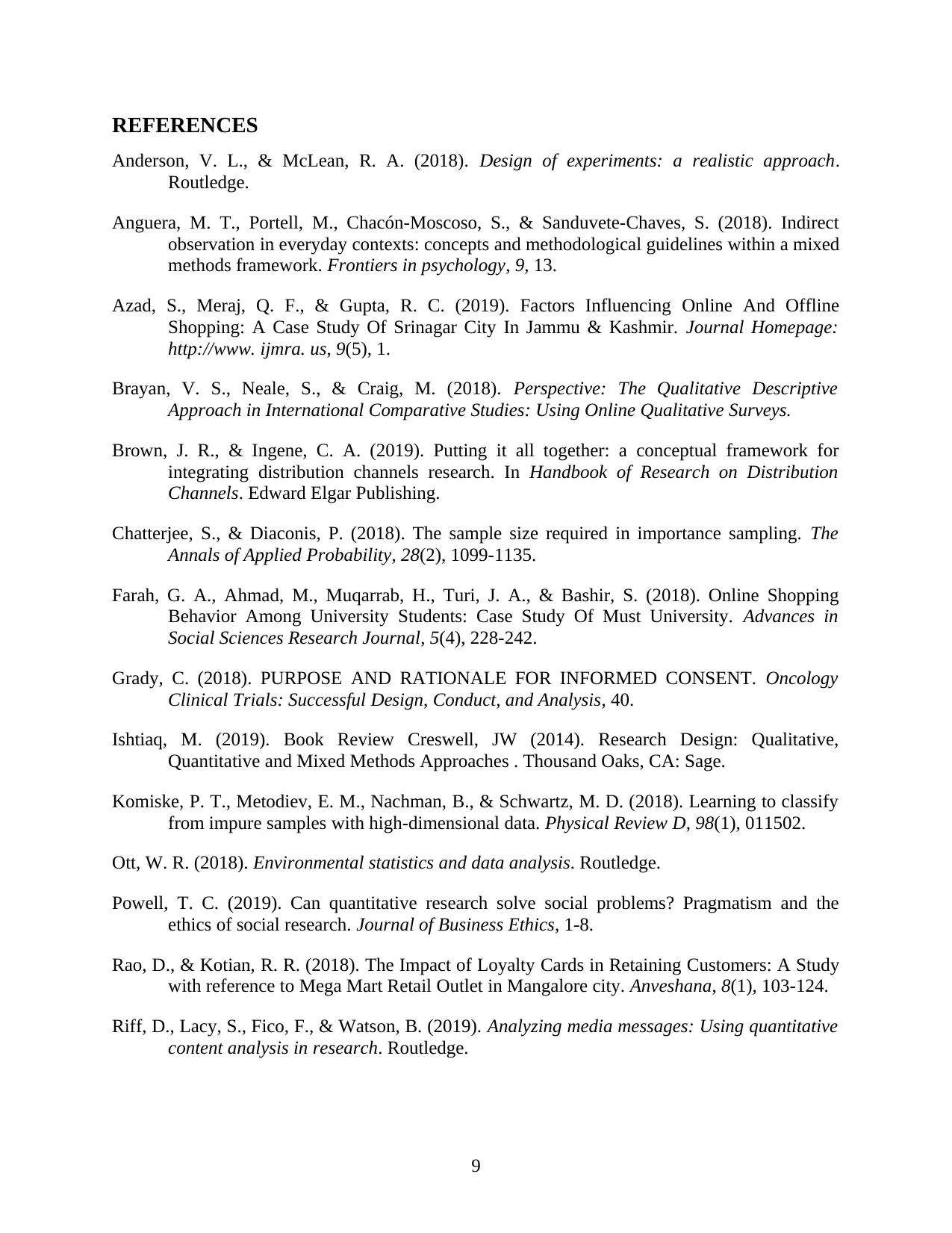
REFERENCES
Anderson, V. L., & McLean, R. A. (2018). Design of experiments: a realistic approach.
Routledge.
Anguera, M. T., Portell, M., Chacón-Moscoso, S., & Sanduvete-Chaves, S. (2018). Indirect
observation in everyday contexts: concepts and methodological guidelines within a mixed
methods framework. Frontiers in psychology, 9, 13.
Azad, S., Meraj, Q. F., & Gupta, R. C. (2019). Factors Influencing Online And Offline
Shopping: A Case Study Of Srinagar City In Jammu & Kashmir. Journal Homepage:
http://www. ijmra. us, 9(5), 1.
Brayan, V. S., Neale, S., & Craig, M. (2018). Perspective: The Qualitative Descriptive
Approach in International Comparative Studies: Using Online Qualitative Surveys.
Brown, J. R., & Ingene, C. A. (2019). Putting it all together: a conceptual framework for
integrating distribution channels research. In Handbook of Research on Distribution
Channels. Edward Elgar Publishing.
Chatterjee, S., & Diaconis, P. (2018). The sample size required in importance sampling. The
Annals of Applied Probability, 28(2), 1099-1135.
Farah, G. A., Ahmad, M., Muqarrab, H., Turi, J. A., & Bashir, S. (2018). Online Shopping
Behavior Among University Students: Case Study Of Must University. Advances in
Social Sciences Research Journal, 5(4), 228-242.
Grady, C. (2018). PURPOSE AND RATIONALE FOR INFORMED CONSENT. Oncology
Clinical Trials: Successful Design, Conduct, and Analysis, 40.
Ishtiaq, M. (2019). Book Review Creswell, JW (2014). Research Design: Qualitative,
Quantitative and Mixed Methods Approaches . Thousand Oaks, CA: Sage.
Komiske, P. T., Metodiev, E. M., Nachman, B., & Schwartz, M. D. (2018). Learning to classify
from impure samples with high-dimensional data. Physical Review D, 98(1), 011502.
Ott, W. R. (2018). Environmental statistics and data analysis. Routledge.
Powell, T. C. (2019). Can quantitative research solve social problems? Pragmatism and the
ethics of social research. Journal of Business Ethics, 1-8.
Rao, D., & Kotian, R. R. (2018). The Impact of Loyalty Cards in Retaining Customers: A Study
with reference to Mega Mart Retail Outlet in Mangalore city. Anveshana, 8(1), 103-124.
Riff, D., Lacy, S., Fico, F., & Watson, B. (2019). Analyzing media messages: Using quantitative
content analysis in research. Routledge.
9
Anderson, V. L., & McLean, R. A. (2018). Design of experiments: a realistic approach.
Routledge.
Anguera, M. T., Portell, M., Chacón-Moscoso, S., & Sanduvete-Chaves, S. (2018). Indirect
observation in everyday contexts: concepts and methodological guidelines within a mixed
methods framework. Frontiers in psychology, 9, 13.
Azad, S., Meraj, Q. F., & Gupta, R. C. (2019). Factors Influencing Online And Offline
Shopping: A Case Study Of Srinagar City In Jammu & Kashmir. Journal Homepage:
http://www. ijmra. us, 9(5), 1.
Brayan, V. S., Neale, S., & Craig, M. (2018). Perspective: The Qualitative Descriptive
Approach in International Comparative Studies: Using Online Qualitative Surveys.
Brown, J. R., & Ingene, C. A. (2019). Putting it all together: a conceptual framework for
integrating distribution channels research. In Handbook of Research on Distribution
Channels. Edward Elgar Publishing.
Chatterjee, S., & Diaconis, P. (2018). The sample size required in importance sampling. The
Annals of Applied Probability, 28(2), 1099-1135.
Farah, G. A., Ahmad, M., Muqarrab, H., Turi, J. A., & Bashir, S. (2018). Online Shopping
Behavior Among University Students: Case Study Of Must University. Advances in
Social Sciences Research Journal, 5(4), 228-242.
Grady, C. (2018). PURPOSE AND RATIONALE FOR INFORMED CONSENT. Oncology
Clinical Trials: Successful Design, Conduct, and Analysis, 40.
Ishtiaq, M. (2019). Book Review Creswell, JW (2014). Research Design: Qualitative,
Quantitative and Mixed Methods Approaches . Thousand Oaks, CA: Sage.
Komiske, P. T., Metodiev, E. M., Nachman, B., & Schwartz, M. D. (2018). Learning to classify
from impure samples with high-dimensional data. Physical Review D, 98(1), 011502.
Ott, W. R. (2018). Environmental statistics and data analysis. Routledge.
Powell, T. C. (2019). Can quantitative research solve social problems? Pragmatism and the
ethics of social research. Journal of Business Ethics, 1-8.
Rao, D., & Kotian, R. R. (2018). The Impact of Loyalty Cards in Retaining Customers: A Study
with reference to Mega Mart Retail Outlet in Mangalore city. Anveshana, 8(1), 103-124.
Riff, D., Lacy, S., Fico, F., & Watson, B. (2019). Analyzing media messages: Using quantitative
content analysis in research. Routledge.
9
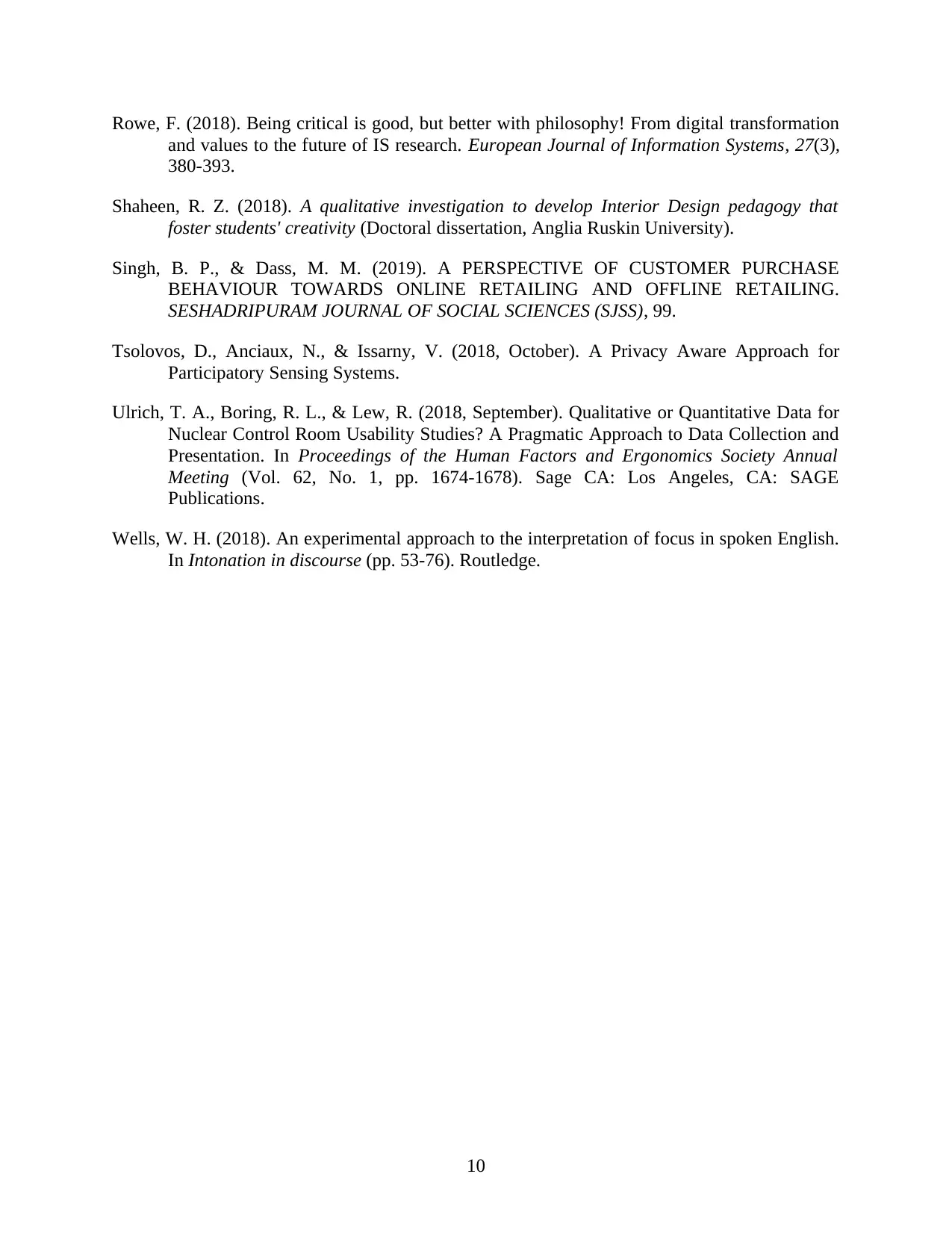
Rowe, F. (2018). Being critical is good, but better with philosophy! From digital transformation
and values to the future of IS research. European Journal of Information Systems, 27(3),
380-393.
Shaheen, R. Z. (2018). A qualitative investigation to develop Interior Design pedagogy that
foster students' creativity (Doctoral dissertation, Anglia Ruskin University).
Singh, B. P., & Dass, M. M. (2019). A PERSPECTIVE OF CUSTOMER PURCHASE
BEHAVIOUR TOWARDS ONLINE RETAILING AND OFFLINE RETAILING.
SESHADRIPURAM JOURNAL OF SOCIAL SCIENCES (SJSS), 99.
Tsolovos, D., Anciaux, N., & Issarny, V. (2018, October). A Privacy Aware Approach for
Participatory Sensing Systems.
Ulrich, T. A., Boring, R. L., & Lew, R. (2018, September). Qualitative or Quantitative Data for
Nuclear Control Room Usability Studies? A Pragmatic Approach to Data Collection and
Presentation. In Proceedings of the Human Factors and Ergonomics Society Annual
Meeting (Vol. 62, No. 1, pp. 1674-1678). Sage CA: Los Angeles, CA: SAGE
Publications.
Wells, W. H. (2018). An experimental approach to the interpretation of focus in spoken English.
In Intonation in discourse (pp. 53-76). Routledge.
10
and values to the future of IS research. European Journal of Information Systems, 27(3),
380-393.
Shaheen, R. Z. (2018). A qualitative investigation to develop Interior Design pedagogy that
foster students' creativity (Doctoral dissertation, Anglia Ruskin University).
Singh, B. P., & Dass, M. M. (2019). A PERSPECTIVE OF CUSTOMER PURCHASE
BEHAVIOUR TOWARDS ONLINE RETAILING AND OFFLINE RETAILING.
SESHADRIPURAM JOURNAL OF SOCIAL SCIENCES (SJSS), 99.
Tsolovos, D., Anciaux, N., & Issarny, V. (2018, October). A Privacy Aware Approach for
Participatory Sensing Systems.
Ulrich, T. A., Boring, R. L., & Lew, R. (2018, September). Qualitative or Quantitative Data for
Nuclear Control Room Usability Studies? A Pragmatic Approach to Data Collection and
Presentation. In Proceedings of the Human Factors and Ergonomics Society Annual
Meeting (Vol. 62, No. 1, pp. 1674-1678). Sage CA: Los Angeles, CA: SAGE
Publications.
Wells, W. H. (2018). An experimental approach to the interpretation of focus in spoken English.
In Intonation in discourse (pp. 53-76). Routledge.
10
⊘ This is a preview!⊘
Do you want full access?
Subscribe today to unlock all pages.

Trusted by 1+ million students worldwide
1 out of 12
Related Documents
Your All-in-One AI-Powered Toolkit for Academic Success.
+13062052269
info@desklib.com
Available 24*7 on WhatsApp / Email
![[object Object]](/_next/static/media/star-bottom.7253800d.svg)
Unlock your academic potential
Copyright © 2020–2025 A2Z Services. All Rights Reserved. Developed and managed by ZUCOL.





